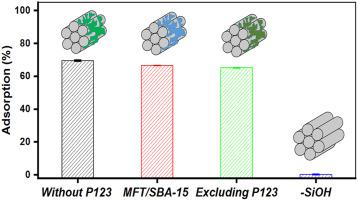Chemosphere ( IF 8.1 ) Pub Date : 2021-03-01 , DOI: 10.1016/j.chemosphere.2021.130112 Ningya Yu , Ke Wu , Liang Tao

|
The usual treatment for Cr(VI)-contaminated wastewater primarily included reduction, adsorption, and the subsequent separation of the Cr-laden adsorbent. Among these factors, the adsorbent is the most critical factor in determining Cr removal efficiency. In this study, a novel melamine-formaldehyde-thiourea (MFT) chelating resin/mesoporous silica composite material (MFT/SBA-15) was synthesized via a co-condensation method and used for the reduction and fixation of Cr(VI)-contaminated water. Cr(VI) adsorption onto MFT/SBA-15 obeyed the pseudo-second-order model, and the chemical adsorption was the rate-limiting step in the adsorption process. Also it followed the Langmuir adsorption model, with single molecular layer adsorption characteristics. The organic components within MFT/SBA-15 were the core functional groups for Cr(VI) adsorption, and the formation of a coordination bond (C=S→Cr) between the lone electron pairs of the S atom and Cr during the adsorption process led to the synchronous reduction-fixation processes of Cr(VI). These synchronous effects were further demonstrated for other reducible heavy metals, including As(V) and Cu(II), but negligibly observed in chemically stable elements, such as Zn(II), Ni(II), Pb(II), Cd(II), and As(III). The novel mesoporous MFT/SBA-15 materials combine the advantages of the chelating resin and mesoporous silica and have excellent potential for the wastewater treatment of reducible heavy metals through synchronous reduction-fixation.
中文翻译:

水溶液中可还原重金属的同步还原固定:新型介孔MFT / SBA-15复合材料的应用
对于受Cr(VI)污染的废水,通常的处理方法主要包括还原,吸附和随后分离负载Cr的吸附剂。在这些因素中,吸附剂是决定Cr去除效率的最关键因素。本研究通过共缩聚法合成了一种新型的三聚氰胺-甲醛-硫脲(MFT)螯合树脂/氧化硅复合材料(MFT / SBA-15),并用于还原和固定受Cr(VI)污染的材料。水。Cr(VI)在MFT / SBA-15上的吸附遵循准二级模型,化学吸附是吸附过程中的限速步骤。它还遵循Langmuir吸附模型,具有单分子层吸附特性。MFT / SBA-15中的有机成分是Cr(VI)吸附的核心官能团,吸附过程中,S原子与Cr的孤电子对之间形成配位键(C = S→Cr),导致Cr(VI)的同步还原固定过程。对于其他可还原重金属,包括As(V)和Cu(II),这些同步效应得到了进一步证明,但在化学稳定元素(如Zn(II),Ni(II),Pb(II),Cd( II)和As(III)。新型介孔MFT / SBA-15材料结合了螯合树脂和介孔二氧化硅的优点,具有通过同步还原固定化处理可还原重金属废水的极好潜力。对于其他可还原的重金属,包括As(V)和Cu(II),这些同步效应得到了进一步证明,但在化学稳定的元素(如Zn(II),Ni(II),Pb(II),Cd( II)和As(III)。新型中孔MFT / SBA-15材料结合了螯合树脂和中孔二氧化硅的优点,具有通过同步还原固定化处理可还原重金属废水的极好潜力。对于其他可还原重金属,包括As(V)和Cu(II),这些同步效应得到了进一步证明,但在化学稳定元素(如Zn(II),Ni(II),Pb(II),Cd( II)和As(III)。新型中孔MFT / SBA-15材料结合了螯合树脂和中孔二氧化硅的优点,具有通过同步还原固定化处理可还原重金属废水的极好潜力。











































 京公网安备 11010802027423号
京公网安备 11010802027423号